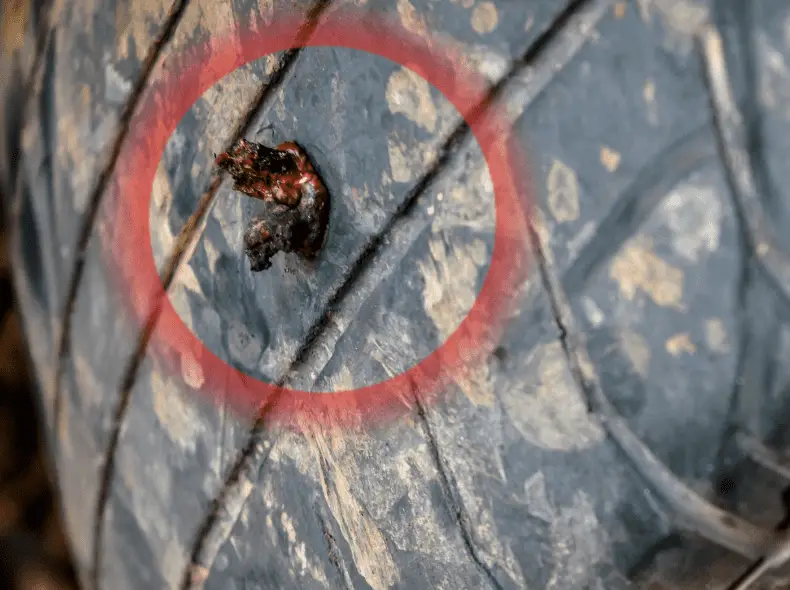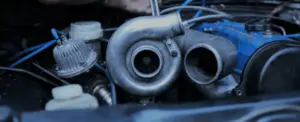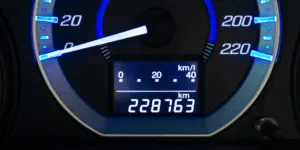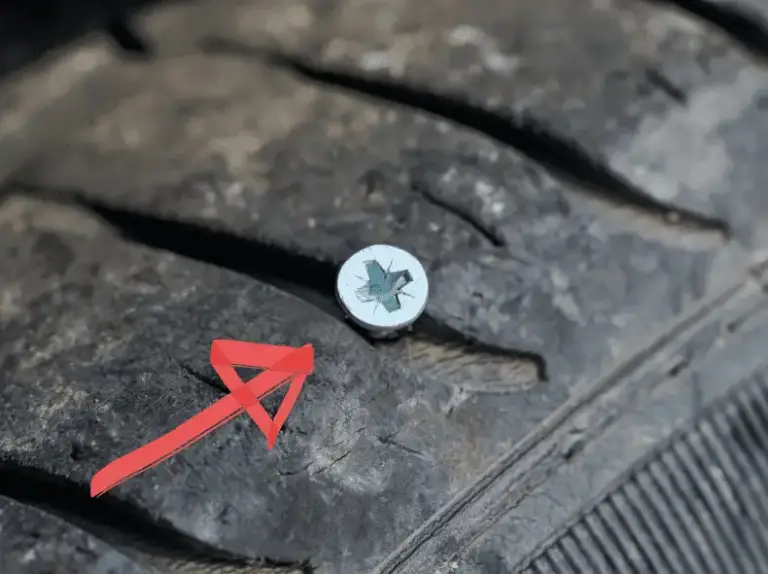At first glance, it may seem like plugging a tire twice is not a good idea. After all, it’s not like you can just keep plugging and expect it to last forever.
But the reality is that plugging a tire twice can be done safely, depending on the location of the second hole or whether you are looking to plug the same hole for a second time.
Let’s get into the specifics.
Plugging The Same Hole Twice
Doing so can weaken the tire and make it more vulnerable it’s best to err on the side of caution. If it leaks once, it will likely leak again if you did the first repair correctly.
If air has escaped, then moisture may have gotten in.
Has the hole got bigger, or has the plug fallen out? Moisture getting inside a tire through a hole is a serious safety hazard that can lead to early tire failure.

When moisture seeps through a hole in the tire, it can weaken the steel tire belts. This is unsafe as the tire may not be able to withstand the pressure of the road, leading to a potential blowout.
Unfortunately, it can be difficult to detect moisture entering your tire, but chances are it has.
It’s not just rain, though. Snow, ice, and freezing temperatures make driving hazardous, but when salt is used to melt snow on roads, it can cause damage to car tires because salt water and steel don’t go well together.
Once it gets inside a tire through a hole, it weakens the tire belts, making the tire unsafe.
Where Can A Second Hole Not Be Plugged?
Within 16 Inches of the First Repair
Plugging a second hole in a tire that is within 16 inches of the first causes the tire to become weak because it creates an extra stress point on the tire.
This extra stress point weakens the tire structure due to the distance between the two holes.
A tire is made up of several layers of rubber, steel belts, and cords. When plugged, tires are never as strong as before.
A second hole weakens the steel belts further and makes the tire more susceptible to blowouts.
Shoulders and Sidewalls
The most common place where tire repair is not possible is when the shoulder or sidewall of the tire gets holes in them.
The problem with plugging a hole in the sidewall is that it doesn’t provide much support. It has no steel belts here, unlike the tread area.
A sidewall is designed to be flexible and provide a cushioning effect when air pressure is pushing down on it. If a hole is plugged, it weakens the support, and the air pressure will push through the plug, causing a blowout.
The shoulder is the outside tread area that slopes away to the sidewall. This area lacks additional support too. Any holes here also mean a new tire is needed.
Can A Tire Be Plugged More Than Twice?
You will unlikely have a third hole 16 inches away from the first two.
So although it would be possible on very large tires with big circumferences on normal vehicles, there is very little chance you could technically repair a tire for a third time.
To be honest, if you have a third hole in your tire, it really is time to dispose of it and buy a brand new one. Chances are the tire belts are weakened because of the third hole and also the likelihood that moisture has saved into the belts and started to rust.
Proper Tire Plugging Procedure
If the first plug you fitted leaked and you are sure you want to plug it again. Here is the best procedure.
1. Locate the Puncture:
If it’s not apparent, i.e., no nail sticking out or a large hole, use soapy water spray when the tire is inflated and look for bubbles.
2. Clean the Puncture:
Before you begin, you must ensure the puncture is clean and free of debris.
Use a reaming tool to enlarge the puncture and remove any leftover material. Then clean away any rubber debris and dirt from the hole.
3. Apply Tire Cement:
The next step is to apply tire cement around the puncture and on the plug itself.

This will help the plug adhere to the tire and create a seal. Use a small brush to apply a thin layer of cement on the plug.
4. Insert the Plug:
Insert the plug into the puncture with a special needle tool that comes in the kit.
Push the plug in until it’s nearly flush with the tire. It’s okay to have a little of the plug sticking out.
5. Let The Plug Sit and Then Inflate
Let the plug and cement bond against the tread rubber for five minutes or so before adding air.
Finally, check the tire pressure to make sure the plug is holding. If it’s not, a new plug needs to be fitted again.
When done correctly, a tire plug can be a cost-effective and reliable way to fix a flat tire.
Just make sure to follow the proper tire plugging procedure and use the right tools and materials.
Often read next:
How Long Does A Tire Plug Last?
Tire Plug Vs Patch Cost [ANSWERED]
Is it legal to plug tires twice?
Plugging and replugging tires can be a safety hazard for drivers. The National Highway Traffic Safety Administration (NHTSA) states that tires can be repaired on the inner tread area of a tire but not on the outer tread area or sidewall.
In Conclusion
It is possible to plug a tire twice but with a few caveats. If you want to plug the same hole again as the first plug is now leaking, moisture or salt water may have gotten inside the tire and weakened the tire belts.
If you are looking to plug again in a second location, this is possible as long as the hole isn’t on the shoulder, the sidewall, or within 16 inches of the first hole.
It’s important to realize that tire plugs are supposed to be a temporary fix, and a tire patch should be fitted instead as soon as you can



![How Long Does It Take To Plug A Tire?[Answered] tire-repair-kit](https://carzaza.com/wp-content/uploads/2023/12/tire-repair-kit-300x224.png)


![Are Plugged Tires Safe To Drive On? [IMPORTANT] Plugged-tire-tread](https://carzaza.com/wp-content/uploads/2023/12/Plugged-tire-tread-300x224.png)



